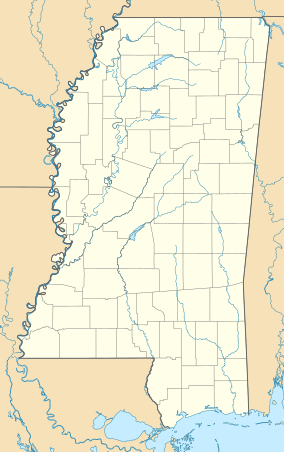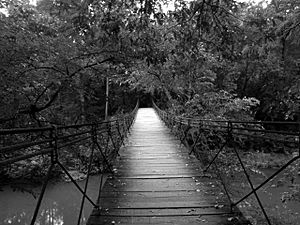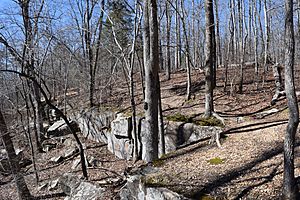Tishomingo State Park facts for kids
Quick facts for kids Tishomingo State Park |
|
|---|---|
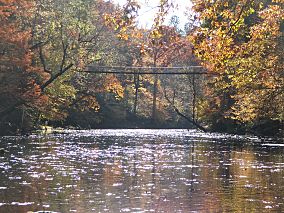
Swinging bridge over Bear Creek
|
|
| Location | Tishomingo, Mississippi, United States |
| Area | 1,530 acres (6.2 km2) |
| Elevation | 515 ft (157 m) |
| Established | 1935 |
| Governing body | Mississippi Department of Wildlife, Fisheries and Parks |
|
Tishomingo State Park
|
|
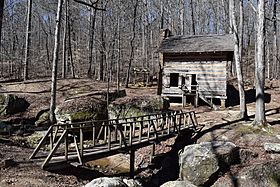
Cabin located within the park
|
|
| Nearest city | Tishomingo, Mississippi |
| Built by | Civilian Conservation Corps |
| Architectural style | Rustic |
| MPS | State Parks in Mississippi built by the CCC MPS |
| NRHP reference No. | 98000275 |
| Added to NRHP | March 26, 1998 |
Tishomingo State Park is a fun outdoor area in Tishomingo County, Mississippi. It's located in the foothills of the Appalachian Mountains. The park is about 45 miles northeast of Tupelo. A main feature of the park is Bear Creek Canyon. It has many cool sandstone rock formations. You can go canoeing, rock climbing, fishing, and hiking here. The park is also found at Milepost 304 of the Natchez Trace Parkway. This is a famous scenic road run by the National Park Service. It remembers the historic Natchez Trace trail.
Contents
Exploring Tishomingo's Unique Landscape
Tishomingo State Park is special because of its amazing rock formations. These huge cliffs and rocks are found here and nearby. You won't see them anywhere else in Mississippi. The park has tall cliffs and many rock outcrops. These are made of sandstone and limestone. They are the very end of the Southern Appalachian Plateau. The large boulders and high cliffs are made of Hartselle Sandstone. There are also outcrops of Bangor Limestone. Bear Creek flows through all of this. Together, they create some of the most beautiful and rugged views in the state.
A Look into Indigenous History
The park is named after Chief Tishu Miko. He was one of the last great leaders of the Chickasaw people. He was born around 1735, not far from the park. Today, some Chickasaw people visit the park. They come to see the places where their famous Chief once fished and hunted.
Chief Tishomingo was a brave leader. He served in the US Military for a long time. He fought in important battles like the Battle of Fallen Timbers. He also fought in the Red Stick Rebellion and the War of 1812. He became very important and had influence in Washington, D.C. He signed many important agreements, called treaties. One was the Treaty of Pontotoc in 1832. He worked on it with Andrew Jackson. However, the Senate never approved it.
His most difficult treaty to sign was the 1837 Treaty of Doaksville. He signed it because of strong political pressure. This agreement helped move the last Chickasaw people from this area. They moved to the Indian Territory in Oklahoma. It is thought that Chief Tishomingo died in May 1838. He was very old, about 104 years old. He likely died from smallpox near Little Rock. This happened during the Trail of Tears. No one knows where he was buried.
The park is also important for even older Native American history. Scientists have found proof that Paleo Indians lived here. This was as early as 7000 B.C. These ancient tribes made excellent tools. They used the good quality chert and limestone found here. They also made pottery from clay dug from the hills.
How Tishomingo State Park Was Built
Tishomingo State Park was built in the 1930s. It was one of many parks built in Mississippi by the Civilian Conservation Corps (CCC). The CCC was a group that helped young men find work during the Great Depression. CCC Company 3497 started building the park in April 1935. The park first opened to visitors in May 1939.
Many of the original buildings and features are still there. These include cabins, picnic tables, and campgrounds. The CCC workers even used a fishing pond they built themselves. The buildings have a rustic look. This is because they used natural materials from the area. The designs were unique, and the builders were very skilled. Most CCC buildings in Mississippi were made of wood. But Tishomingo and Wall Doxey state parks used a lot of stone.
Fun Things to Do at the Park
Tishomingo State Park has seven hiking trails. They are from ¾ to 3 miles long. Some are easy, and some are a bit harder. The trails offer beautiful views. You can see natural springs, waterfalls, and rocky creeks. There are also cliffs and huge rock formations. The land looks like mountains, and it is part of the Appalachian range. But the hills here are not super high, about 660 feet.
Rock climbing is a popular activity. You need a helmet and a free permit from the park office. A favorite spot is called Jean's Overhang. You can also explore Bear Creek by canoe. The park offers special canoe trips.
The park has three disc golf courses. There is also a large outdoor swimming pool. It is open in late spring and summer. If you want to stay overnight, there are many choices. You can find 15 simple campsites. There are also two Scout campsites. For RVs, there are 62 sites with water and electricity. Plus, there are seven furnished cabins.
The park's Nature Center reopened in 2016. It has displays about Tishomingo County's history. You can learn about nature, art, and animals. There are also arrowheads and items from the Civilian Conservation Corps.
- - Mississippi Department of Wildlife, Fisheries, and Parks
Images for kids


